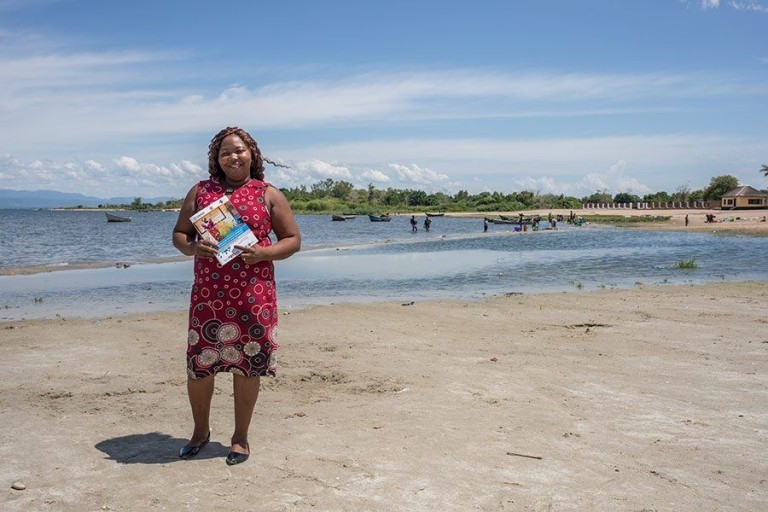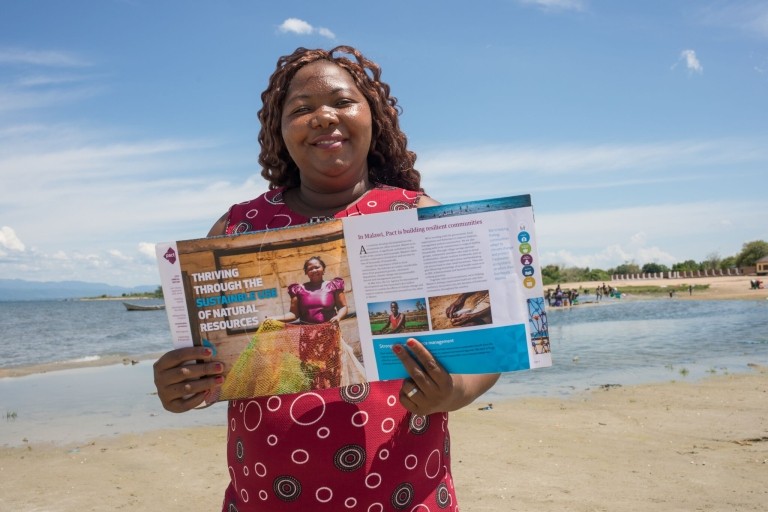Blog
Finding a familiar face – and progress – amid Malawi's FISH

In 2015, Monica Mazuwa didn’t seem disillusioned. But as she talked about the challenges facing beach village committees, I wondered how she wasn’t. She was candid about their work at the time, “The beach village committees are struggling. They aren’t organized. They barely function.”
As an Enforcement Officer with the Department of Fisheries, Monica was responsible for monitoring the southeast and southwest arms of Lake Malawi, Upper Shire and Lake Malombe for illegal fishing practices and for confiscating illegal nets. That’s a big task – and an even bigger one when you consider the limited resources available to Monica and her team. They were supposed to go on daily patrols of the lake, but only had the fuel to patrol monthly. And they were supposed to work closely with the community-led beach village committees, known as BVCs. But, as Monica noted, those were barely functioning.
Monica and I met in November 2015, when I was a program officer backstopping Pact’s USAID-funded Fisheries Integration of Society and Habitats (FISH) project in Malawi. At the time, I worked with the operations, finance and grants teams, so the majority of my trip was spent in meetings in florescent-lit rooms in Lilongwe. But the project was in desperate need of photographs, and as an aspiring – but not yet skilled – photographer, I was the perfect, low-budget solution. We carved out thirty-six hours and I headed to Mangochi for a whirlwind tour of FISH sites.
As we drove from site to site, Dick Kachilonda, the governance and capacity development specialist, explained how Pact was targeting BVCs to improve their ability to monitor fishing activities on the lakes. According to Dick, it wasn’t only about building their capacity, it was also about their legitimacy in the eyes of communities and fishermen. During our short visit with Monica, she reiterated those points. At that time, the FISH project had only just started engaging with BVCs and, as Monica made very clear, we had a long way to go.
…
Before we left, I ask Monica if she was willing to pose holding an illegal fishing net. She was the perfect subject: She exuded determination and confidence. The mid-day sun cast shadows on her face before reflecting off of her striking pink shirt. She held the illegal fishing net, extending it to her right so that the bright green, yellow and red ropes were highlighted by the faded, whitewashed Department of Fisheries building in the background. We’d end up using that picture on the cover of Pact Malawi’s Organization Network Analysis Report for the FISH project as well as in Pact’s 2015 Annual Report.

In the months and years that followed, Monica’s picture kept passing across my desk and popping up on my computer screen. Each time I look at that photo, I remember Monica walking around the Fisheries compound showing us confiscated nets, shaking her head as she talked about how many more were still out there on the lake.
I remember the group of men waiting in the shade, glaring in her direction, annoyed that their nets had been taken away. I remember the determined tone of her voice when she said, “Being a woman? The culture here respects men more than women. They see you coming and they say, ' She cannot take anything.' But little by little…”
When I look at that picture, I also remember her message, clearly stated between the lines of the hard facts she delivered in our short time together: We can barely keep up with the illegal activity on the lakes. How is the FISH project going to help me do my job?”
…
The FISH project wasn’t designed to directly help Monica do her job. While the project works closely with the Department of Fisheries, it doesn’t support or directly fund DoF enforcement activities. However, for Monica and other enforcement officers, having a cadre of strong, organized BVCs would be a game changer, allowing DoF to work in partnership with communities and fishermen – instead of against them.
So, despite not being directly involved in the FISH project, Monica was following its progress.
In 2015, much of the project work to date was focused on a variety on in-depth research initiatives led by the University of Rhode Island Coast Resource Center. It was important, foundational work that defined the project’s direction for the coming years. And it was an exciting time: There was a clear sense of momentum and possibility. Relationships were being built and connections made – lots of movement under the surface, but…not quite a concrete narrative to tell.
At the time, I didn’t know how to write that story. But I saved the notes.
…
It’s 2018 and Monica Mazuwa still doesn’t seem disillusioned. Tired, for sure. Frustrated, yes. Even angry at times. But still not disillusioned. Again, as I listen to her speak, I wonder how.
Even her children, Praise, 10, and Patience, 8, have grown weary. They’ve already decided that they won’t work at the Department of Fisheries when they grow up because, as they tell Monica, “When you come home from work, you always seem so stressed and angry.”
But Monica is still in it. “Right now, our concentration is on chasing. When we have fuel, we chase and confiscate. But we don’t have the manpower to focus on other issues we should be working on too, like licensing. The last two years, work has been hectic. Hectic, hectic, hectic. The flock of illegal fishers is tremendous, and we still don’t have the resources to fight it.
“That time we talked in 2015, there was uncontrolled illegal fishing. And since then it’s been a very tough two years. There are still many illegal fishermen. Life goes on. We go to work. The fishermen know they are breaking the law. They know their gears are illegal. But they will catch more fish with the illegal nets. So they will continue.”
This time, however, the conversation shifts away from the challenges and I see that Monica is excited, hopeful. First, she tells me about vessel monitoring systems (VMS), which the FISH project piloted and is now helping FAO/FIRM to get up and running. “These VMS gadgets will allow us to better monitor the fishermen. Once we have them we can track the fishermen via GPS. This will be so helpful.”
Then, the BVCs. The moment of truth – did anything change? Have we made any difference? As soon as Monica started talking, the stark contrast between her frustrated 2015 assessment of BVCs and her now animated, enthusiastic description was evident. The progress was impressive, exciting, inspiring. In Monica’s eyes, the best BVCs aren’t just a little more organized: They’re exceeding expectations. They’re going above and beyond. Change is happening.
I believe in capacity development, I know it works – I’ve seen the results in many of Pact’s projects. But hearing Monica’s stories, I couldn’t help but ask, “So they’re really functioning that well?”
They are. Monica explains it best:
“The BVCs have been revamped and are working tirelessly. They are doing very commendable work! They are now so organized. We haven’t confiscated many illegal gears compared to what the BVCs are doing now. We get calls from sources who don’t want to see the depletion of protected areas. These sources are BVC members and community members. We are now getting more calls than we got two years ago. The BVCs and the Fisheries Association members, they are always calling me on the phone, saying, 'Madam! You can’t rest!'
“The BVCs and communities take the fishing sanctuaries very seriously. Once there was a commercial fishing boat passing very near to one. My friends, I did not sleep that night with the calls from the BVC and community members.
“BVCs are even doing water patrols on their own now. They are not waiting on us to be able to. They are really trying. Some of the BVCs from Lake Malombe came to our office. They said: 'We need fuel to do patrols!' I said: 'We don’t have any.' You know what they did? They mobilized. They got the money for fuel themselves and they started patrolling.
“During the closed season, we didn’t even go to southwest area for any patrols – the BVCs are doing it perfectly. And just wait, with the new BVC bylaws in place, things will change. Next time you come, things will be even better.”
She continued, making it clear that there was still work to be done. “We still need the FISH project for the next phase of this work. Please, please don’t go away. Can you lobby for another project? That would be great if you can continue the work. Most especially from the BVC side. Our department cannot cover the area we are supposed to cover, but if we can have BVCs everywhere – it would be great.
“USAID is doing a tremendous job. They are helping the government control fisheries resources. Maybe in the future we’ll target BVCs that are not doing well? Or maybe we target new BVCs? If we have BVCs all along Lake Malawi, it could be bingo.”
“It could be bingo?” I ask.
“Bingooo!” Monica replies.
I'd never heard the phrase before, but I instantly love it. It makes me think about playing the game with my grandmother, who considered herself an expert in its nuances. I have a subtle, hard-to-explain connection to the word that makes me smile, and I try to explain that to Monica.
She gets it – she has a similar (though admittedly deeper and more profound) connection to fishing with her late father. A connection that might be what keeps her from becoming disillusioned even when so much of her work seems chaotic and uncontrollable.
“I love fishing. My father was a fisherman and he was able to send me to school because of the fish in our lakes. I’m working in the Fisheries Department because of those fish. I want to take care of them…because there is someone out there like me, someone who needs those fish to go to school. Wherever my father is, he is seeing me working on his behalf.”
…
Monica and I stand facing each other. I’m holding a camera again, but this time, instead of the illegal net, Monica holds the photograph of herself holding the net. We’ve both evolved: I’m now the Creative Content Manager on the communications team at Pact – and a real photographer. Monica’s now a District Enforcement Officer at the Department of Fisheries.

The BVCs, however, are perhaps the most evolved of all in the two years since we met, progressing from disorganized and barely functional to thriving, respected partners for the Department of Fisheries. There’s more work to do, of course – sustainable sources of funding for the BVCs need to be secured and Management Agreements, which grant full co-management rights to communities through Fisheries Associations, still need to be signed at the highest echelons of the DoF.
But the progress is impressive – and BVCs continue to exceed expectations despite the challenges, the limited resources, the continued illegal fishing, and all the things that make me ask myself: How is Monica not disillusioned? And Monica knows there’s more progress coming. She promises that next time I visit, it will be even better. I’ll keep my notes.